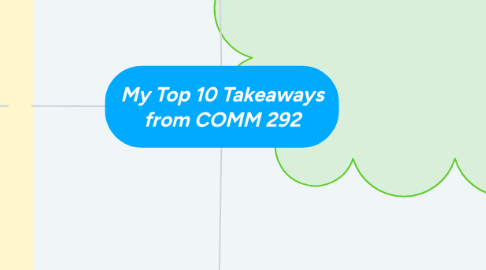
1. Individual Level
1.1. Motivations
1.1.1. Needs Theory
1.1.1.1. Maslow's Hierarchy of Needs
1.1.1.2. Two-factor Theory
1.1.2. Motivators
1.1.2.1. Extrinsic
1.1.2.1.1. Monetary Incentives
1.1.2.2. Intrinsic
1.1.2.2.1. Recognition
1.1.2.2.2. Complement
1.1.3. Expectancy Theory
1.1.3.1. Focus
1.1.3.1.1. Improving expectancy
1.1.3.1.2. Improving instrumentality
1.1.3.1.3. Improving valence
1.1.3.2. Implementation
1.1.3.2.1. Giving constructive feedback
1.1.3.2.2. Celebrating success teammates achieved
1.1.3.2.3. Properly reward teammates who well-contributed
1.1.4. Goal-setting Theory
1.2. Emotions
1.2.1. Expressed by verbal and non-verbal expression
1.2.1.1. Verbal
1.2.1.2. Non-verbal
1.2.1.2.1. Facial Expression
1.2.1.2.2. Gesture and Posture
1.2.2. Impacts
1.2.2.1. Positive
1.2.2.1.1. Critical to rational thinking
1.2.2.2. Negative
1.2.2.2.1. Employees Deviance
1.2.3. Emotional Labour
1.2.3.1. Services sector
1.2.3.2. Pretending one is in a specific emotion
1.2.3.3. Causes emotional dissoance
1.2.4. Emotional Intelligence
1.2.4.1. Ability to perceive emotions in self and others
1.2.4.2. Understanding the meaning of emotions perceived
1.2.4.3. Regulating emotions accordingly
1.2.4.3.1. E.g. How to express anger without violating norms
1.3. Diversity
1.3.1. Types of Diversity
1.3.1.1. Cultural
1.3.1.1.1. Norms
1.3.1.1.2. Habits
1.3.1.2. Demographical
1.3.1.2.1. Age
1.3.1.2.2. Races
1.3.1.2.3. Gender
1.3.1.3. Behavioural
1.3.1.3.1. Occupation
1.3.1.3.2. Educational Level
1.3.1.3.3. Social Class
1.3.2. Causes
1.3.2.1. Globalization
1.3.2.2. Advancement of Technology
1.3.3. Importance & Effects
1.3.3.1. Necessary when dealing with inter-fields challenges
1.3.3.2. Culturally-shaped viewpoints enhance comprehensiveness of solution
1.3.3.3. Making sure the solution works in different scenario / countries and is able to attract target audiences
2. Group Level
2.1. 5 Stages of Group Development
2.1.1. The 5 Stages
2.1.1.1. Forming
2.1.1.1.1. Potential Conflicts
2.1.1.2. Storming
2.1.1.2.1. Potential Conflicts
2.1.1.3. Norming
2.1.1.3.1. Objectives
2.1.1.4. Performing
2.1.1.5. Adjourning
2.2. Team Building & Bonding
2.2.1. Team Bonding
2.2.1.1. Objectives
2.2.1.1.1. Build up mutual trust
2.2.1.1.2. Enhance mutual-understanding
2.2.1.1.3. Develop deeper relationship
2.2.1.2. Implementation
2.2.1.2.1. Informal gathering
2.2.2. Team Building
2.2.2.1. Objectives
2.2.2.1.1. Excite team spirit
2.2.2.1.2. Drill teamwork skills
2.2.2.2. Implementation
2.2.2.2.1. Join team building campaign
2.3. Role Ambiguity
2.3.1. Causes
2.3.1.1. Ineffective communication
2.3.1.1.1. Silences
2.3.1.1.2. Filtering
2.3.1.2. Lack mutual-understanding
2.3.1.2.1. Do not know other team members' strengths and weaknesses
2.3.2. Potential Risk
2.3.2.1. Waste of resources
2.3.2.1.1. Waste of human power
2.3.2.1.2. Waste of time
2.3.2.2. Intra-group argument
2.3.3. Solution
2.3.3.1. Manage role expectation
2.3.3.1.1. Responsibilities each role have to take
2.3.3.1.2. Technical skills each role require
2.3.3.1.3. Connections each role require
2.3.3.2. Better allocate human resources and other resources
3. Organizational Level
3.1. Leadership Style
3.1.1. Importance
3.1.1.1. Providing visionary goals
3.1.1.2. Establishing visions, missions, values (VMV)
3.1.1.3. Socializing and promoting VMV and organizational culture
3.1.1.4. Coaching and mentoring
3.1.2. Inspirational Leadership & Transformational Leadership
3.1.2.1. Motivating
3.1.2.1.1. Providing recognition
3.1.2.1.2. Rewarding
3.1.2.2. Inspiring
3.1.2.3. Helping subordinates to transcend their interest for the good of the organization
3.1.2.4. Exert all potential of oneself and others
3.1.2.4.1. Boost productivity for the organization
3.1.3. Becoming a leader
3.1.3.1. Learning by observing, practicing and involving
3.1.3.2. Acquiring self-leadership skills
3.1.3.2.1. Mentoring
3.1.3.2.2. Shadowing
3.2. Communication
3.2.1. Importance
3.2.1.1. Allow employees voice their advice
3.2.1.1.1. Sooth dissatisfaction
3.2.1.1.2. Managers can implement internal adjustment according to employees' opinions
3.2.2. Multiple Obstacles
3.2.2.1. Filtering
3.2.2.2. Emotions
3.2.2.3. Cultural barriers
3.2.2.4. Language barriers
3.2.3. Fostering Effective Communication
3.2.3.1. Choosing appropriate channels for communication
3.2.3.1.1. Guarantee richness
3.2.3.2. Communication should be ...
3.2.3.2.1. Transparant
3.2.3.2.2. Concise
3.2.3.2.3. Accurate
3.2.3.2.4. Rational
3.3. Decision Making
3.3.1. Importance
3.3.1.1. Strongly and positively correlated to job performance
3.3.1.2. Making wrong decision can cause huge losses
3.3.2. Multiple Obstacles
3.3.2.1. Bounded Rationality
3.3.2.1.1. Easily affected by emotions and moods
3.3.2.2. Overconfidence bias
3.3.2.3. Risk aversion
3.3.2.3.1. Too low risk-taking level
3.3.3. Making Best Possible Decisions
3.3.3.1. Individual
3.3.3.1.1. Efficient
3.3.3.1.2. High speed
3.3.3.1.3. Less human power used
3.3.3.2. Groupthink
3.3.3.2.1. More complete information
3.3.3.2.2. Enhanced quality of solution
3.3.3.2.3. Increased diversity of views
3.3.3.2.4. Creativity
3.3.3.3. Must be ethical in practise
3.3.3.4. Affected stakeholders' right must be respected
3.4. Organizational Culture
3.4.1. Vary depending on nature, missions,and visions of organization
3.4.2. Positive organizational culture
3.4.2.1. Types
3.4.2.1.1. Encouraging listening
3.4.2.1.2. Welcoming
3.4.2.2. Influence
3.4.2.2.1. Boost productivity
3.4.2.2.2. Reduce turnover rate
3.4.2.2.3. Lower the overall cost
3.4.2.2.4. Improve efficiency
3.4.2.2.5. Enhance company’s identity
3.4.2.2.6. Nurture sense of belonging
3.4.2.3. Top management's role
3.4.2.3.1. Being a role model
3.4.2.3.2. Socializing culture
3.4.2.3.3. Promoting culture

